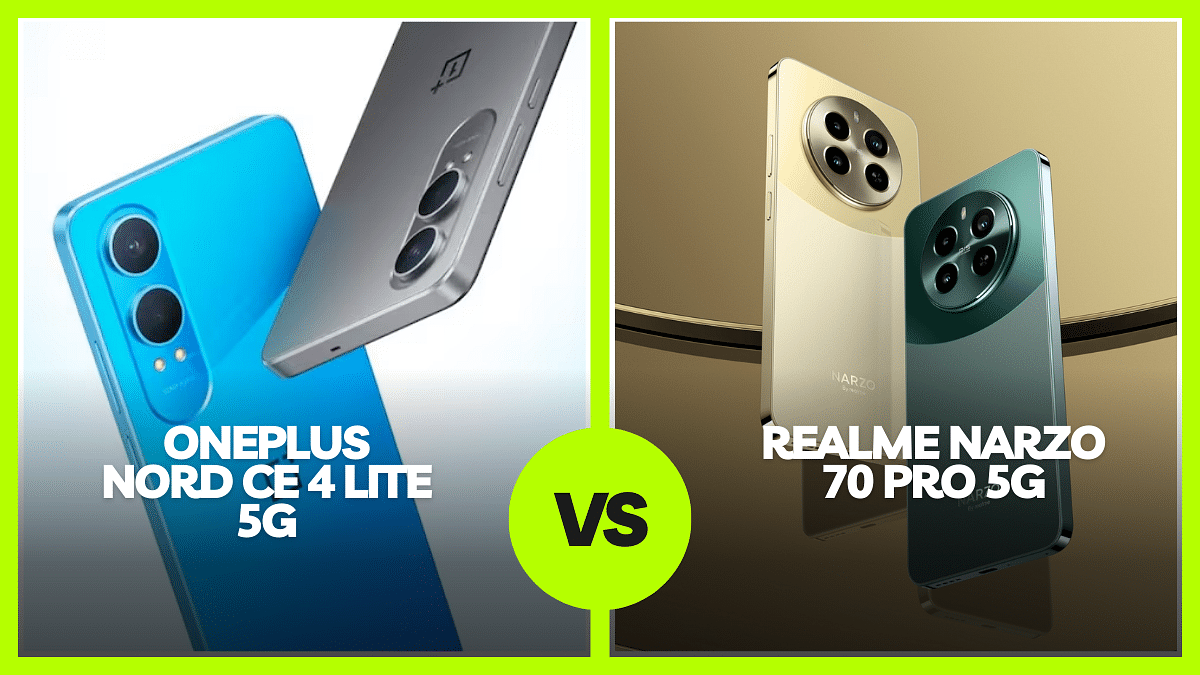In India’s affordable 5G smartphone market, the OnePlus Nord CE 4 Lite 5G and Realme Narzo 70 Pro 5G are standout options, each appealing to tech enthusiasts with distinct features. Priced competitively and equipped with advanced features like fast charging and high-refresh-rate displays, these devices cater to diverse user preferences.
The OnePlus Nord CE 4 Lite 5G emphasizes a superior AMOLED display and fast 80W SuperVOOC charging, while the Realme Narzo 70 Pro 5G focuses on performance with MediaTek’s Dimensity chipset and a robust camera setup. This comparison highlights their key features to help you make a smart decision. Let’s get started
Also Read | OnePlus Nord CE 4 Lite 5G Top Alternatives: Best Picks Under Rs. 20,000
Design And Display
| Specs | OnePlus Nord CE 4 Lite 5G | Realme Narzo 70 Pro 5G |
| Display | 6.67-inch AMOLED, 120Hz refresh rate, 2,100 nits peak brightness | 6.67-inch OLED, 120Hz refresh rate, 2,000 nits peak brightness |
Both the OnePlus Nord CE 4 Lite 5G and Realme Narzo 70 Pro 5G showcase unique designs and vibrant displays. The Nord CE 4 Lite features a 6.67-inch AMOLED display with 2,100 nits peak brightness and a 120Hz refresh rate. It includes Aqua Touch technology for usability with wet fingers and comes in Super Silver, Mega Blue, and Ultra Orange colors.
In contrast, the Narzo 70 Pro 5G boasts a 6.67-inch full-HD+ OLED display with a 120Hz refresh rate and a peak brightness of 2,000 nits. It showcases a Horizon Glass Design with a dual-tone finish, providing a premium aesthetic appeal.
Performance
| Specs | OnePlus Nord CE 4 Lite 5G | Realme Narzo 70 Pro 5G |
| Processor | Snapdragon 695 5G | MediaTek Dimensity 7050 |
| RAM | Up to 8GB | 8GB |
| Storage | Up to 256GB | 128GB, 256GB |
The OnePlus Nord CE 4 Lite 5G runs on the Snapdragon 695 5G chipset and OxygenOS 14.0 based on Android 14. It offers up to 8GB of RAM and up to 256GB of storage.
On the other hand, the Realme Narzo 70 Pro 5G is powered by the MediaTek Dimensity 7050 chipset and Mali-G68 GPU, coupled with 8GB of RAM and up to 256GB of storage.
Battery
| Specs | OnePlus Nord CE 4 Lite 5G | Realme Narzo 70 Pro 5G |
| Battery | 5,500mAh, 80W SuperVOOC fast charging | 5,000mAh, 67W SuperVOOC fast charging |
The OnePlus Nord CE 4 Lite 5G device packs a 5,500mAh battery with 80W SuperVOOC fast charging, capable of fully charging in just 52 minutes. Meanwhile, the Realme Narzo 70 Pro 5G houses a slightly smaller 5,000mAh battery but supports 67W SuperVOOC fast charging for quick recharging.
Camera
| Specs | OnePlus Nord CE 4 Lite 5G | Realme Narzo 70 Pro 5G |
| Camera (Rear) | 50MP primary, 2MP depth sensor | 50MP primary, 8MP ultra-wide, 2MP macro |
| Camera (Front) | 16MP | 16MP |
In terms of camera setups, the OnePlus Nord CE 4 Lite 5G features a 50MP primary camera with OIS and a 2MP depth sensor on the rear, along with a 16MP front-facing camera for selfies. It boasts an IP54 rating for water and dust resistance, ensuring durability.
Conversely, the Realme Narzo 70 Pro 5G offers a triple rear camera setup led by a 50MP primary sensor with OIS, an 8MP ultra-wide camera, and a 2MP macro sensor. For selfies, it features a 16MP front camera. Both devices provide robust imaging capabilities suitable for various photography needs.
Software And Features
| Specs | OnePlus Nord CE 4 Lite 5G | Realme Narzo 70 Pro 5G |
| OS | OxygenOS 14.0 based on Android 14 | Realme UI 5.1 based on Android 14 |
| Special Features | Aqua Touch, IP54 rating | Air Gesture controls, Horizon Glass Design |
OnePlus Nord CE 4 Lite 5G runs on OxygenOS 14.0 based on Android 14, providing a clean and customizable user experience. It includes features like Aqua Touch and promises timely software updates.
In comparison, the Realme Narzo 70 Pro 5G operates on Realme UI 5.1 based on Android 14, offering a user-friendly interface with features like Air Gesture controls for touchless interactions. Realme commits to providing extended software support, ensuring longevity for the device.
Price And Availability
| Specs | OnePlus Nord CE 4 Lite 5G | Realme Narzo 70 Pro 5G |
| Price | Starts at Rs. 19,999 | Rs. 18,999 (8GB RAM + 128GB), Rs. 19,999 (8GB RAM + 256GB) |
The OnePlus Nord CE 4 Lite 5G is priced starting at Rs. 19,999 for the 128GB variant, going up to Rs. 22,999 for the 256GB model, with availability from June 27 on multiple platforms including Amazon India. It comes with an initial discount offer for ICICI Bank credit cardholders.
In contrast, the Realme Narzo 70 Pro 5G is priced competitively at Rs. 18,999 for the base model and Rs. 19,999 for the higher storage variant, emphasizing affordability within the mid-range segment.
Also Read | OnePlus Introduces Nord CE 4 Lite 5G In India At Rs. 19,999: A Closer Look At Its Features
Final Verdict
Both the OnePlus Nord CE 4 Lite 5G and Realme Narzo 70 Pro 5G cater to consumers looking for feature-rich smartphones at competitive prices. The OnePlus device excels in display technology, fast charging capabilities, and software experience, while the Realme option offers a powerful chipset, impressive camera setup, and stylish design. The choice between them would depend on specific preferences for display quality, battery performance, and software interface, aligning with individual user priorities in the mid-range smartphone market.

